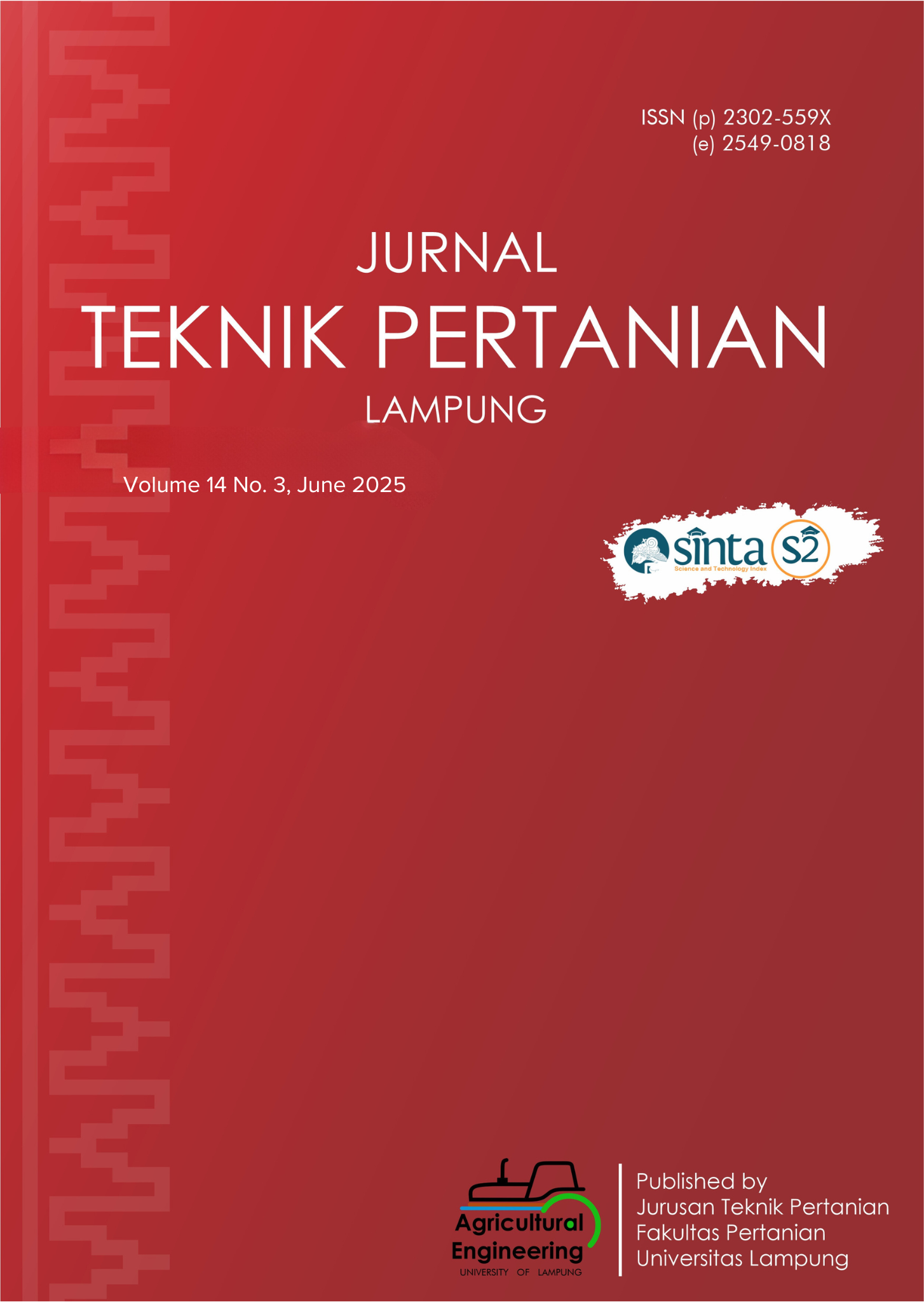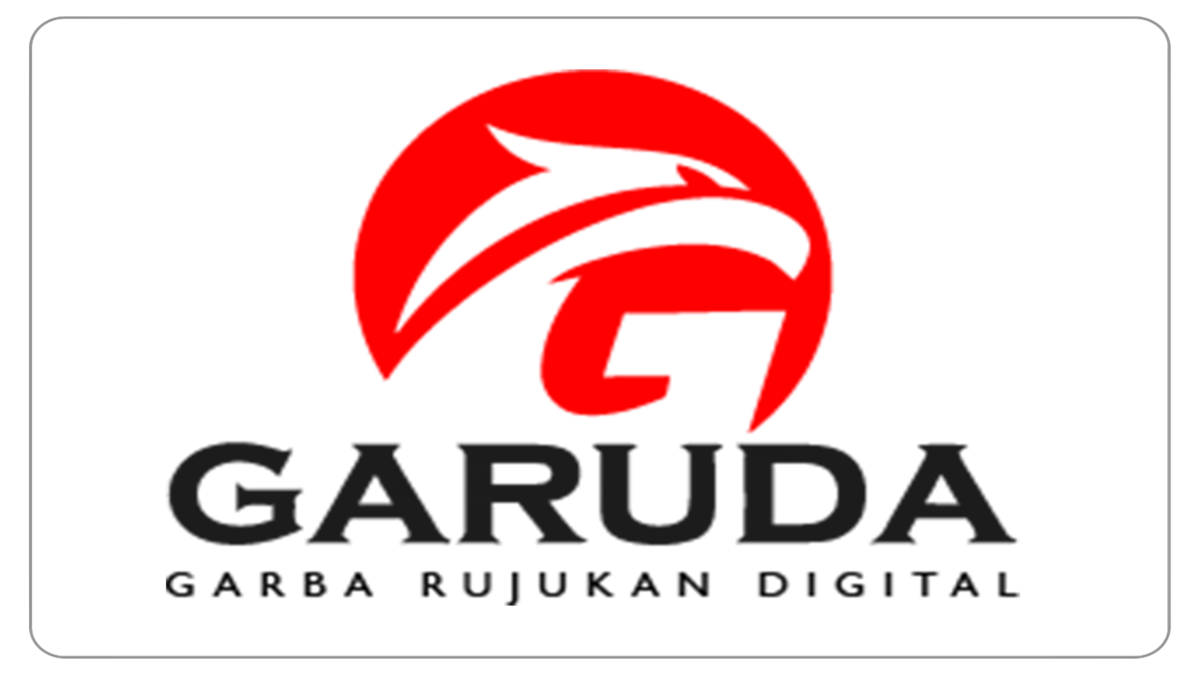Drying Characteristics of Cayenne Pepper (Capsicum frutescens L.) Using a Rotary Rack Hybrid Dryer with Blanching Pretreatment Application
DOI:
https://doi.org/10.23960/jtep-l.v14i3.1085-1097 Abstract View: 121
Abstract View: 121
Abstract
Proper post-harvest handling is very necessary to maintain product quality and extend the shelf life. One way to extend the shelf life of agricultural products, including cayenne pepper (Capsicum frutescens L.), is by drying techniques. Blanching pretreatment before drying can maintain the condition of the dried product so that it can maintain the final product quality. The aim of this research was to analyze the water content, water content ratio (MR), drying rate, drying constant of cayenne pepper using a rotary rack type of hybrid dryer. The use of rotary racks type hybrid dryer is a cheaper drying alternative and the use of rotary racks is able to standardize the water content in the cayenne pepper drying process. The research was carried out with two treatments, namely with and without blanching process at a temperature of 90°C for 5 min. The second factor was drying temperatures were are 43 47℃, 48-52℃ and 53-57℃ until the cayenne pepper reach the water content according to the reference, namely in the range of 5-8%. From the research results, it was obtained that the lowest water content of cayenne pepper was given pretreatment blanching at a temperature of 53-57°C, namely 6.43% with a drying time of up to 14 h. The drying rate of blanched cayenne pepper was higher than that of unblanched cayenne pepper.
Keywords: Blanching, Cayenne pepper, Drying.
Downloads
References
Abustang, N.F., & Sushanti, G. (2022). Analisis laju pengeringan dengan metode regresi linear pada pembuatan ebi vannamei (Litopenaeus vannamei) menggunakan mesin cabinet dryer. Agrokompleks, 22(1), 42-50. https://doi.org/10.51978/japp.v22i1.378
Anoraga, S.B., Sabarisman, I., & Ainuri, M. (2018). Effect of different pretreatments on dried chilli (Capsicum annum L.) quality. IOP Conference Series: Earth and Environmental Science, 131(1), 012014. https://doi.org/10.1088/1755-1315/131/1/012014
Bilang, M., Laga, A., & Djawas, T. (2018). Pendugaan umur simpan cabai bubuk fermentasi dari cabai rawit (Capsicum frutences L.) dan cabai merah (Capsicum annuum L.) menggunakan metode akselerasi pendekatan Labuza. Jurnal Teknologi Pangan, 11(2), 13-22. https://doi.org/10.33005/jtp.v11i2.892
Effendy, A.B.S. (2016). Modifikasi pati tapioka secara cross-linking dengan menggunakan natrium asetat. [Undergraduate thesis]. Fakultas Matematika dan Ilmu Pengetahuan Alam, Universitas Lampung.
Fadhilatunnur, H., Suryatman, S., Murtadho, Z., & Tjahja, M. (2022). Pengeringan cabai merah (Capsicum annuum L.) dengan kombinasi oven microwave dan kipas angin. Jurnal Mutu Pangan Indonesian Journal of Food Quality, 9(1), 26-35. https://doi.org/10.29244/jmpi.2022.9.1.26
Gonçalves, E.M., Pereira, N., Silva, M., Alvarenga, N., Ramos, A.C., Alegria, C., & Abreu, M. (2023). Influence of air-drying conditions on quality, bioactive composition and sensorial attributes of sweet potato chips. Foods, 12(6), 1198. https://doi.org/10.3390/foods12061198
Hariyadi, T. (2018). Pengaruh suhu operasi terhadap penentuan karakteristik pengeringan busa sari buah tomat menggunakan tray dryer. Jurnal Rekayasa Proses, 12(2), 104-113. https://doi.org/10.22146/jrekpros.39019
Hasibuan, R., & Gusman, H. (2018). Effect of operation conditionasi on Gelugur acid (Garcinia atroviridis) drying rate using tray dryer. Talenta Conference Series: Science and Technology (ST), 1(2), 160-167. https://doi.org/10.32734/st.v1i2.293
Hasibuan, R., Hasibuan, H., Madani, Y.N., Pramananda, V., Fazillah, R., & Alexander, V. (2023). Pengaruh kondisi operasi terhadap karakteristik pengeringan jahe merah (Zingiber officinale var. rubrum) menggunakan tray dryer dengan udara panas dari proses pirolisis. Jurnal Teknik Kimia USU, 12(2), 84–91. https://doi.org/10.32734/jtk.v12i2.11496
Irfan, A.M., Lestari, N., Arimansyah, A., & Rasyid, A.R. (2021). Kinetika pengeringan cabai dengan perlakuan blansing suhu rendah-waktu lama. Agritekno: Jurnal Teknologi Pertanian, 10(1), 24. https://doi.org/10.30598/jagritekno.2021.10.1.24
Kamsiati, E., Rahayu, E., & Herawati, H. (2020). Pengaruh blanching terhadap karakteristik daun ubi kayu instan. METANA, 16(1), 39–46. https://doi.org/10.14710/metana.v16i1.30461
Khaerunnisya, N., & Rahmawati, E. (2019). Pengaruh metode blanching pada proses pengeringan cabai. Journal of Food and Culinary, 2(1), 27-32. https://doi.org/10.12928/jfc.v2i1.1569
Khathir, R., Rahmawati, M., Syah, H., & Zahari, M.P. (2023). Pengaruh metode blanching terhadap karakteristik pengeringan cabai rawit hijau menggunakan alat pengering terowongan Hohenheim Aceh. Jurnal Teknologi Pengolahan Pertanian, 4(2), 61-71. https://doi.org/10.35308/jtpp.v4i2.6614
Muhandri, T., Yulianti, S.D., & Herliyana, E.N. (2017). Karakteristik pengeringan jamur tiram (Pleurotus ostreatus var. florida) menggunakan pengering tipe Fluidized Bed Drier. Agritech, 37(4), 420–427. https://doi.org/10.22146/agritech.10619
Nauly, D. (2017). Fluktuasi dan disparitas harga cabai di Indonesia. Jurnal Agrosains dan Teknologi, 1(1), 57–70.
Owusu-Kwarteng, J., Kori, F.K.K., & Akabanda, F. (2017). Effects of blanching and natural convection solar drying on quality characteristics of red pepper (Capsicum annuum L.). International Journal of Food Science, 2017(1), 4656814. https://doi.org/10.1155/2017/4656814
Putra, A.S., & Kuncoro, H. (2021). Pengaruh kondisi pengeringan dengan kelembaban dan suhu rendah terhadap penyusutan temulawak. Jurnal Teknologi Pertanian Andalas, 25(1), 81–89.
Ramdani, H., Wicaksono, R.A., & Fachruddin, M.A. (2018). Penambahan Natrium Metabisulfit (Na2S2O5) terhadap Vitamin C dan warna pada proses pengeringan cabai merah (Capsicum annuum L.) dengan Tunnel Dehydrator. Jurnal Agronida, 4(2). https://doi.org/10.30997/jag.v4i2.1572
Safrina, D., Susanti, D., & Khotimah, A.N. (2023). Analisis konstanta laju pengeringan dan karakter simplisia bunga kamilen (Matricaria chamomilla L.) dengan beberapa metode pengeringan. Agrointek: Jurnal Teknologi Industri Pertanian, 17(2), 394–403.
Samreen, Madhava, M., & Rama Rao, A. (2017). Drying of red chilli in photovoltaic powered greenhouse dryer. International Journal of Engineering Technology Science and Research, 4(9).
Saputri, L., Lewuras, A.M.P., Minah, F.N., & Astuti, S. (2022). Pengaruh suhu dan waktu pengeringan terhadap kadar air dan kadar vitamin C pada bubuk cabai rawit (Capsicum frutescens L.). Prosiding SENIATI 2022 (BOOK-3), 6(3), 636-643. https://doi.org/10.36040/seniati.v6i3.4942
Sari, D.K., & Lestari, R.S.D. (2016). Pengaruh laju alir udara pengering terhadap pengeringan kulit manggis. Teknika: Jurnal Sains dan Teknologi, 12(1), 35–42.
Tanggasari, D., & Jatnika, A.R. (2023). Pengaruh pengeringan lapis tipis jagung (Zea mays L) sebagai bahan pakan dengan suhu yang berbeda. Jurnal Keteknikan Pertanian Tropis dan Biosistem, 11(1), 73–81. https://doi.org/10.21776/ub.jkptb.2023.011.01.07
Tobing, I.F., Mustaqimah, M., & Agustina, R. (2019). Modifikasi pengering tipe tray dryer dengan penambahan insulator. Jurnal Ilmiah Mahasiswa Pertanian, 4(4), 422–431.
Widyasanti, A., Pratiwi, R.A.N., & Nurjanah, S. (2018). Pengaruh proses blansing dan suhu pengeringan terhadap karakteristik leder buah (fruit leather) terong Belanda (Chyphomandra betaceae Sendt.). Jurnal Pangan dan Gizi, 8(2), 105–118.
Yosika, N.I.W., Hawa, L.C., & Hendrawan, Y. (2020). Karakteristik pengeringan cabai puyang (Piper retrofractum vahl.) menggunakan pengeringan alami (Open sun drying). Jurnal Teknologi Pertanian, 21(3), 165–174.
Downloads
Published
How to Cite
Issue
Section
License
Authors who publish with this journal agree to the following terms:
Authors retain copyright and grant the journal right of first publication with the work simultaneously licensed under a Creative Commons Attribution-ShareAlike 4.0 International Lice that allows others to share the work with an acknowledgement of the work's authorship and initial publication in this journal.
Authors are able to enter into separate, additional contractual arrangements for the non-exclusive distribution of the journal's published version of the work (e.g., post it to an institutional repository or publish it in a book), with an acknowledgement of its initial publication in this journal.
Authors are permitted and encouraged to post their work online (e.g., in institutional repositories or on their website) prior to and during the submission process, as it can lead to productive exchanges, as well as earlier and greater citation of published work (See The Effect of Open Access).
Jurnal Teknik Pertanian Lampung

JTEPL is licensed under a Creative Commons Attribution-ShareAlike 4.0 International License.













